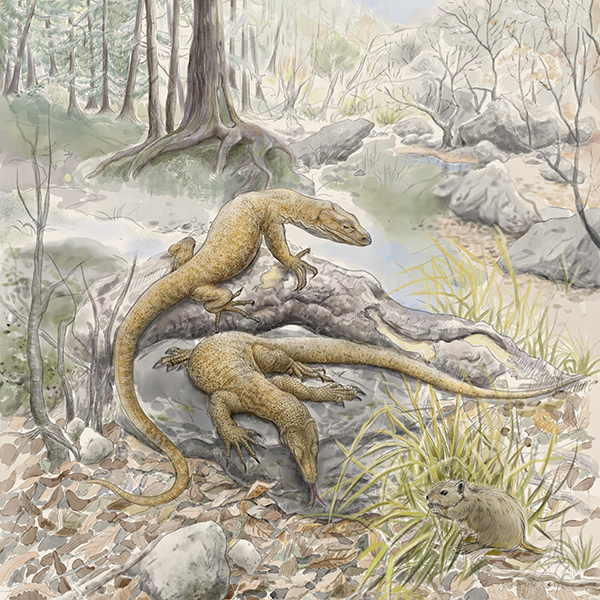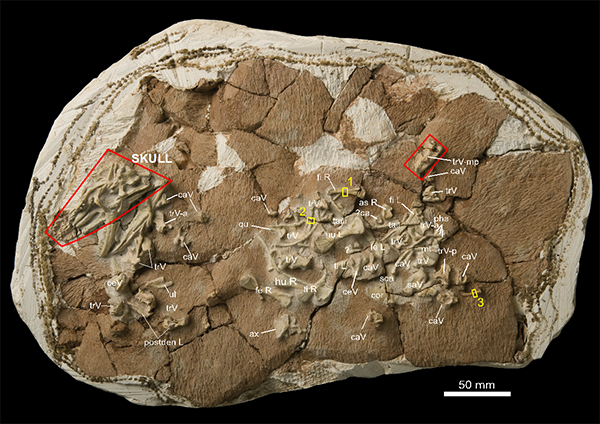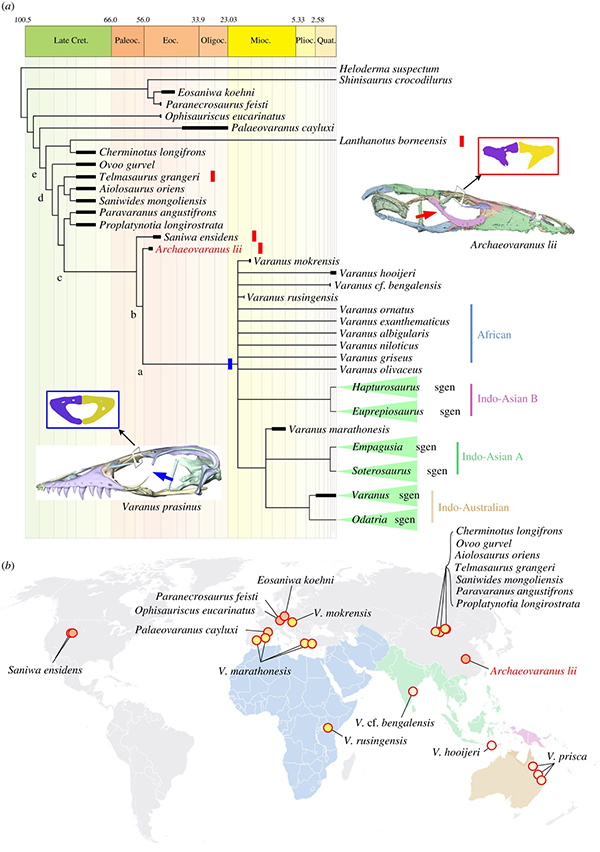| Location: Home > Research > Research Progress |
| New Varanid Fossil from China Supports Asian Origin of Varanidae |
|
A study based on a new varanid fossil species from China shows that the transition from the ancient Varaniformes to Varanus occurred in Asia and supports the Asian origin of Varanidae. The study was published in Philosophical Transactions of the Royal Society B on Feb. 7. It was conducted by researchers from the Institute of Vertebrate Paleontology and Paleoanthropology (IVPP) of the Chinese Academy of Sciences and their collaborators from the UK and Switzerland. The lizard family Varanidae, whose Chinese name literally means giant lizard, is one of the most successful groups of lizards. Its sole extant genus Varanus encompasses more than 80 living species currently distributed across Africa, Asia and Australia, as well as a few close fossil relatives. It is commonly accepted that Varanidae originated from the Varaniformes of the Late Cretaceous of Eurasia, with well-preserved fossils reported from the Upper Cretaceous of the Gobi Desert of Mongolia and China. However, the origin of the genus Varanus has been of great debate, with Asian, African, and Gondwanan hypotheses proposed. The earliest definitive Varanus fossils come from the early Neogene. Bridging the Late Cretaceous and the Neogene, the Paleogene is then the key period for the transition from Varaniformes to Varanus. However, the only well-represented fossils from this key time are the Saniwa skeletons from North America where Varanus does not currently exist, thus further clouding the evolutionary history of Varanidae. The new varanid fossil from China, Archaeovaranus lii, was excavated by a research group led by Prof. WANG Yuanqing of IVPP from the Lower Eocene of the Liguanqiao Basin in Hubei Province in 2008. Archaeovaranus was about one meter long. It shares many features with Varanus, such as its elongated snout, intramandibular joint, and precondylar constriction, but it also differs from Varanus in its open subolfactory canal and orbit, palatal teeth, and lesser degree of coracoid fenestration. What is most characteristic in Archaeovaranus is the similar length of the forelimb and hindlimb (not including the manus and pes). In contrast, Varanus’s hindlimb is obviously longer than its forelimb. Such a body proportion suggests that Archaeovaranus employed a specialized locomotion at least different from the contemporaneous Saniwa of North America. The Archaeovaranus individual represented by the fossil had matured sexually at the age of five and died at 16. Archaeovaranus also highlights the evolution of some feeding-related characters within the family Varanidae. From the stem varanids to Varanus, the opening of the orbit increased the efficiency of feeding, while the closing of the subolfactory canal helped neutralize the growing stress created by the opening of the orbit. Meanwhile, the retention of palatal teeth in Archaeovaranus suggests a complicated history of tongue function from the prey transition in other lizards to chemosensation in Varanus. This work was supported by the National Natural Science Foundation of China, the Strategic Priority Research Program (B) of the Chinese Academy of Sciences, and the Youth Innovation Promotion Association.
Figure 1. Reconstruction of Archaeovaranus lii
Figure 2. Holotype of Archaeovaranus lii from the Eocene of Liguanqiao Basin
Figure 3. Phylogeny of Varaniformes (a) and geographic location of the varaniforme fossils (b): Archaeovaranus lii is the closest relative of the genus Varanus |


